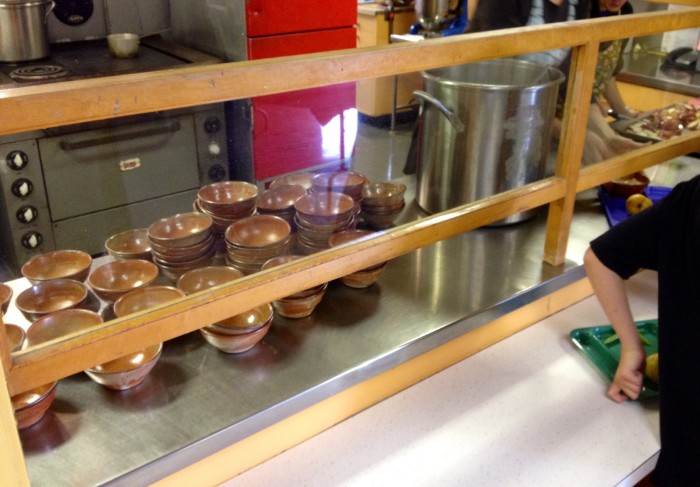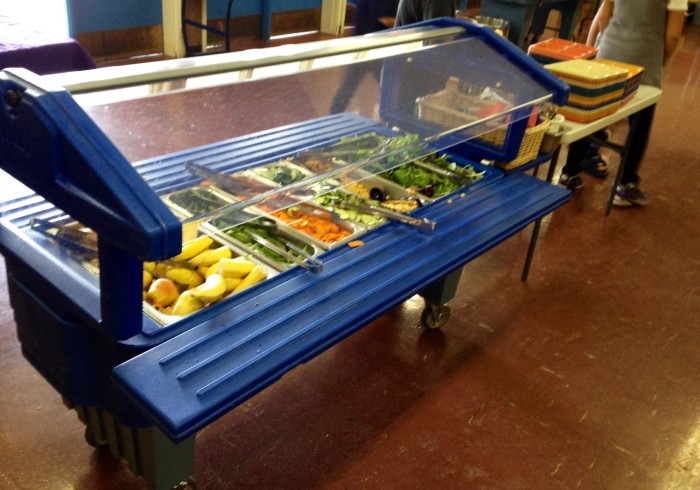I’m proud to work at a charter school with a scratch kitchen where, for the last two years, our lunches have been made with local organic produce. Around seventy percent of our students eat in the cafeteria everyday.
When our Village School Kitchen first started two years ago we were featured on Jamie Oliver’s Food Revolution blog. This year one of the self-dubbed “Healthy Lunch Ladies” approached me asking for input on creating a few fully vegan lunch options to roll into the already mostly vegetarian (the school serves a meat option one time per week) lunch lineup.
School lunches are pretty tricky to organize. Over fifty-three percent of the students at our school qualify for free lunches and the school relies on a subsidy from the government to cover the cost of the food. They get about $3.00 per lunch from the government as a subsidy. Non-subsidized lunches bring in $3.40. The requirements for school lunches are stringent.
To meet USDA requirements, the average school meal, analyzed weekly, must:
-
Contain no more than 30 percent of calories from fat
-
Contain no more than 10 percent of calories from saturated fat
-
Provide one-third of the Dietary Reference Intakes (DRIs) for calories, protein, vitamin A, vitamin C, iron, and calcium (from Physicians Committee for Responsible Medicine)
I asked Toña Aguilar, one of our healthy lunch ladies, a few questions about meeting nutrition requirements and while serving healthy lunches.
Q: What are the requirements for protein, fiber, fat, whole grains, veggies, etc, for an average lunch?
A: Requirements are divided into the following categories: grain, meat or meat alternative, fruit, vegetable, and milk. Grains must be at least 50% whole. Trans fats are now banned, saturated fat and sodium must fall under a certain amount per week. Grain and meat/ meat alternatives must equal one oz equivalent per day with minimums (for the grades we serve) at 8/9 per week. When the new requirements took effect there were maximums on the number of servings per week as well as caloric maximums but there were so many (well publicized) complaints that they lifted the maximums. Schools/districts participating in the National School Lunch Program must offer fruits and vegetables every day and students must take 1/2 cup fruit and/or vegetables, along with two other components to qualify for a reimbursable meal. We are an “offer versus serve” program; many elementary schools across the nation are still “serve” programs, where the child simply gets a tray pre-portioned.
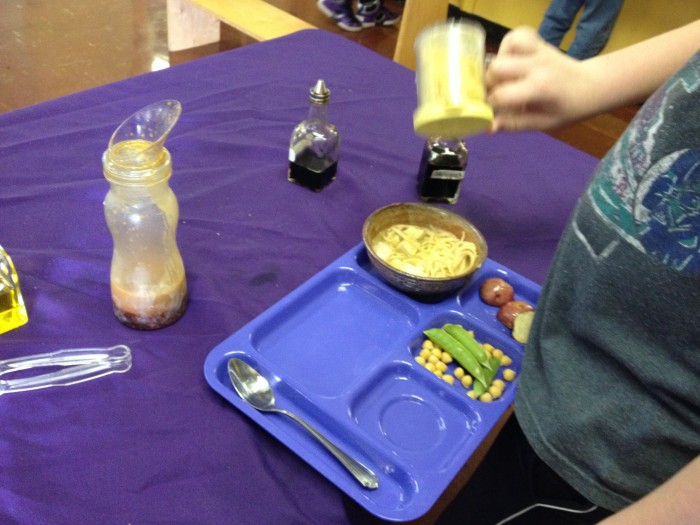
Q: What is your biggest challenge in creating healthy lunches?
A: Having enough helping hands to create these meals from scratch and then clean up every day. It is quite an undertaking to accomplish what we do day after day and stay positive and healthy and sane.
Q: Why do you want to add in more vegan lunches?
A: Organic and local are priorities for us. Organic meat and dairy are expensive! Vegan meals tend to be more affordable. They also appeal to a wide range of customers. They encourage creativity on the kitchen’s part. The creation of vegan meals has less of an impact on natural resources. We are committed to using as much local and organic meat and dairy as we can, but they still come in plastic!Unfortunately many great sources of plant based protein do not fall within the meat/meat alternative category. Tofu was recently added, but tempeh and and quinoa don’t count at all. Students get tired of beans if we serve them day after day.
Q: What is something important you think people should know about what you do?
A: Nourishing children with nutritious, wholesome food made with love is essential to their education. You can’t send a child to school without breakfast, or feed them fries and soda pop for lunch and expect them to engage in a meaningful way. Their bodies need to be nourished first and then their minds and hearts.
We love what we do and we have fun doing it. The second graders harvested kale and collards from the school garden last week. They were so proud of what they grew and presented it to me with giant grins on their faces. One little boy told me he didn’t like to eat greens but he couldn’t wait for us to serve them so he could try them again.
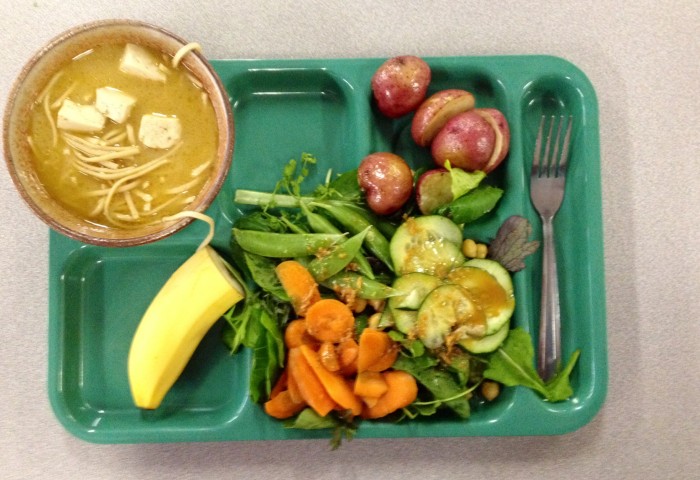 (Vegan Lunch: Miso with tofu, roasted potatoes, salad and banana)
(Vegan Lunch: Miso with tofu, roasted potatoes, salad and banana)
The Village School Kitchen is an inspirational model for the future of school lunch programs. Our kitchen shows that healthy lunches can meet nutritional guidelines AND be economical. Further, vegan lunches are even more likely to be successful in meeting these goals, all while reducing the negative impact on the environment. Vegan lunches are a win-win.
The old lunch program, which was nearly identical to the food from my own middle school, was a sore spot for the students. The food wasn’t prepared from scratch. It arrived well preserved–frozen or canned or hermetically sealed in plastic. It only needed to be opened and heated before serving. It’s the same now for other schools, just a few blocks away. I looked at the nutrition facts and ingredient information page for our district schools. The page was under construction and listed only a few items. I clicked on the baked potato and was surprised to see that it had more than fifteen ingredients, including Calcium Disodium EDTA (which is made with formaldehyde) and artificial flavorings.
None of this escaped the understanding of the our past students. They knew the food was not healthy. They knew they were getting the short end of the stick. We talked about it occasionally in class meetings. They felt uncared for. They asked for better. It took years before our administration was able to answer their request, not for lack of trying.
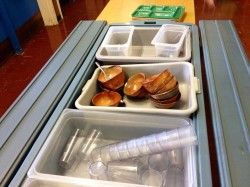 (The dish depository)
(The dish depository)
Food plays a much larger role in schools than people give credit. Since the change in lunch management, the numbers of students getting lunches (and breakfasts) has increased dramatically. I’ve noticed that with the improvements in taste, freshness, nutrition, and even the aesthetics of the food we are served, everyone is happier. They’re excited for lunch time, and not just because we have a break from academics. At least once a day I hear someone ask “do you know what’s for lunch today?” The students are happier, and they feel better cared for. As their teacher, I also feel better cared for, especially as a vegan. The menu featured mac and cheese this past Friday, and I was served penne noodles with a delicious cauliflower based “cheese” sauce. I was so pleased I texted home to let my partner know how awesome my lunch was.
Watching students joyfully sprinkle gomashio onto their salad, discussing which dressing is better with carrots, and going to the salad bar for seconds, is awesome. This blanket of nutritional care spills out of the cafeteria doors as well…I can see it and feel it in the halls and classrooms and on the playground of our school. Our school was amazing before this lunch program and now we are approaching–and I say this with utter (ahem) objectiveness–absolute coolness. I’m hopeful that our lunch program is setting a trend that others could follow.
 (Compost and napkins)
(Compost and napkins)
All this begs the question: Why don’t more schools offer healthier lunches with vegan friendly options, when it is clear that nutrition and health (both of the Earth and of our own bodies) are paramount to quality education? What needs to change to make healthy lunches the norm in our schools?
I put this question to Andy Peara, the executive director at the Village School:
I think the answer lies in organizational change, creating ownership for the food programs in schools, and finding clever ways to solve the challenges of cost.
Food Costs: We spend roughly $1.40-$1.50 per lunch on food, which many food service administrators have considered impossible by their standards. I recall our district saying they could afford about 65 cents on food for lunch several years ago, though it’s probably risen since then.
The importance of ownership: A large district also has to cater to a lot of different people. The near unanimous acceptance of our food program has been a gift for our school. Our population is in no way uniform socio-economically, but there is fairly strong consensus favoring organic and local food. Our program grew out of our school. Our lunch coordinators were school parents who were responsive to the opinions we gathered. They started the program expecting to prepare food on site, with volunteer help. When they began, the response was very positive from students and staff. From the beginning, most teachers ate the school meals with their students, and this helped reinforce acceptance of our program.
Organizational Change: Our history and experience suggests that making a positive change in food service requires a sensitive assessment of a school’s needs and inclinations to create buy-in from students, parents, and staff, but it also requires a careful transition with existing food service staff. Unlike our staff, most food service staff at other public schools have been hired under the assumption that they would heat and serve, keep the kitchen clean, and work well with kids. Asking them to prep and cook food might be like asking a middle school math instructor to teach integral calculus. Making big changes is uncomfortable for most people. Perhaps more important, the new expectations may feel unjust, as they may not be part of their original agreement. If the feeling of injustice is strong enough, making significant changes may require a lot retraining and rebuilding of trust, which is difficult in tight financial times.
Andy’s answer was echoed by our healthy lunch ladies, Stacey Black and Toña Aquilar. Toña said that
Educators (parents, teachers, etc) and policy makers need to be educated on optimal nutrition in a way that inspires change. There needs to be a shift in thought and values regarding the interconnectedness of living systems.
The most effective, positive changes I hear about are on the small scale, students and parents pushing for changes in their schools and districts. Although . . . the changes that recently happened at federal level are significant in that they are updated requirements which affect the way millions of children eat every day. Unfortunately, it took decades for those small changes to come about. With the state of our nation in terms of health, we can’t wait another few decades for more updates!
Stacey added that
If a school or district is already serving school lunches and participating in the National School Lunch Program, the only changes that need to be made are things like intention and will. People have to care, invest and commit. We have a choice to purchase and prepare whole foods or not. There are unlimited healthy options and ways to create a healthy lunch program.
Never doubt that a small group of thoughtful, committed, citizens can change the world. Indeed, it is the only thing that ever has.
-Margaret Mead
It would seem that the real change that needs to happen is at the small level. Small changes do add up to big change. It takes teamwork, community, and work, but we can make a different in this important realm. Giving care and commitment and pushing for positive change will allow us to better nourish our children so that they can go on to do their best work AND it will allow us to better care for our planet. Our Village School is a perfect example that it can work.
Also by Susana: Opinion – What Is Carnism?
Related: Explaining Veganism to Your Children
___
Photo: Susana Romatz

